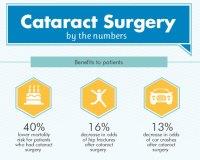Assessing The Pros And Cons Of Traditional Cataract Surgery Compared To Laser-Assisted Techniques
Assessing The Pros And Cons Of Traditional Cataract Surgery Compared To Laser-Assisted Techniques
Blog Article
Writer-Bush Bach
When pondering the choice between traditional cataract surgical procedure and laser-assisted strategies, you may find yourself weighing the advantages and disadvantages each method supplies. The choice exceeds the surface area level of expense and accuracy, diving right into the world of long-lasting results and individual complete satisfaction. As you browse with the complexities of these two techniques, it becomes essential to recognize the nuanced details that can significantly affect your visual quality and general experience. Keep tuned to discover the crucial variables that will lead your decision-making procedure in this critical element of eye treatment.
Standard Cataract Surgery Pros and Cons
When thinking about standard cataract surgical treatment, you might locate that it's a well-established and widely-used technique. In this procedure, a cosmetic surgeon makes a small incision in the eye and uses ultrasound to separate the cloudy lens prior to removing it. As soon as the cataract is eliminated, a fabricated lens is put to bring back clear vision.
One of the major benefits of traditional cataract surgery is its performance history of success. Many patients have actually had their vision dramatically enhanced via this procedure. Additionally, what is cataracts surgery is typically covered by insurance, making it a much more obtainable option for many individuals.
However, there are Laser LASIK Surgery to traditional cataract surgical treatment too. Healing time can be longer compared to newer techniques, and there's a somewhat greater risk of difficulties such as infection or swelling. Some clients may likewise experience astigmatism or require analysis glasses post-surgery.
Laser-Assisted Techniques Advantages And Disadvantages
Checking out laser-assisted methods for cataract surgical procedure introduces a modern approach that uses laser modern technology to execute vital steps in the procedure. One of the primary advantages of laser-assisted cataract surgical treatment is its precision. The laser enables very accurate cuts, which can result in far better aesthetic results. Furthermore, using lasers can lower the amount of ultrasound power required throughout the surgery, potentially lowering the danger of complications such as corneal damages.
On the disadvantage, laser-assisted techniques can be more expensive compared to conventional approaches. This price mightn't be covered by insurance policy, making it much less obtainable to some clients.
An additional factor to consider is that not all cataract surgeons are trained in laser technology, which might limit your alternatives for selecting a surgeon.
Lastly, while the laser can automate specific elements of the procedure, the surgical procedure still needs a knowledgeable specialist to make certain effective results.
Relative Analysis of Both Techniques
For an extensive understanding of cataract surgical treatment techniques, it's vital to perform a relative analysis of both traditional and laser-assisted approaches.
Typical cataract surgical treatment includes hands-on incisions and making use of handheld devices to separate and eliminate the cloudy lens.
On the other hand, laser-assisted cataract surgical procedure uses advanced technology to produce exact lacerations and separate the cataract with laser power prior to removing it.
In regards to accuracy, laser-assisted methods use a higher degree of precision contrasted to traditional approaches. Making use of lasers allows for personalization of the procedure based upon each person's eye anatomy, possibly causing far better visual results.
Nevertheless, laser-assisted cataract surgery has a tendency to be more expensive than traditional surgical procedure, which might limit ease of access for some patients.
While both techniques are effective in restoring vision impaired by cataracts, the choice in between traditional and laser-assisted techniques commonly relies on variables such as expense, accuracy, and individual client needs.
Consulting with your eye doctor can aid establish one of the most suitable method for your cataract surgical treatment.
Verdict
In conclusion, when choosing between typical cataract surgical procedure and laser-assisted techniques, take into consideration elements like price, precision, and individual needs. Standard surgical treatment provides a tried and tested performance history and insurance policy coverage yet may come with longer recovery times. Laser-assisted techniques provide greater precision and modification but can be much more costly and not constantly covered by insurance. Ultimately, the choice in between the two approaches relies on what is most important to you and your specific scenario.
